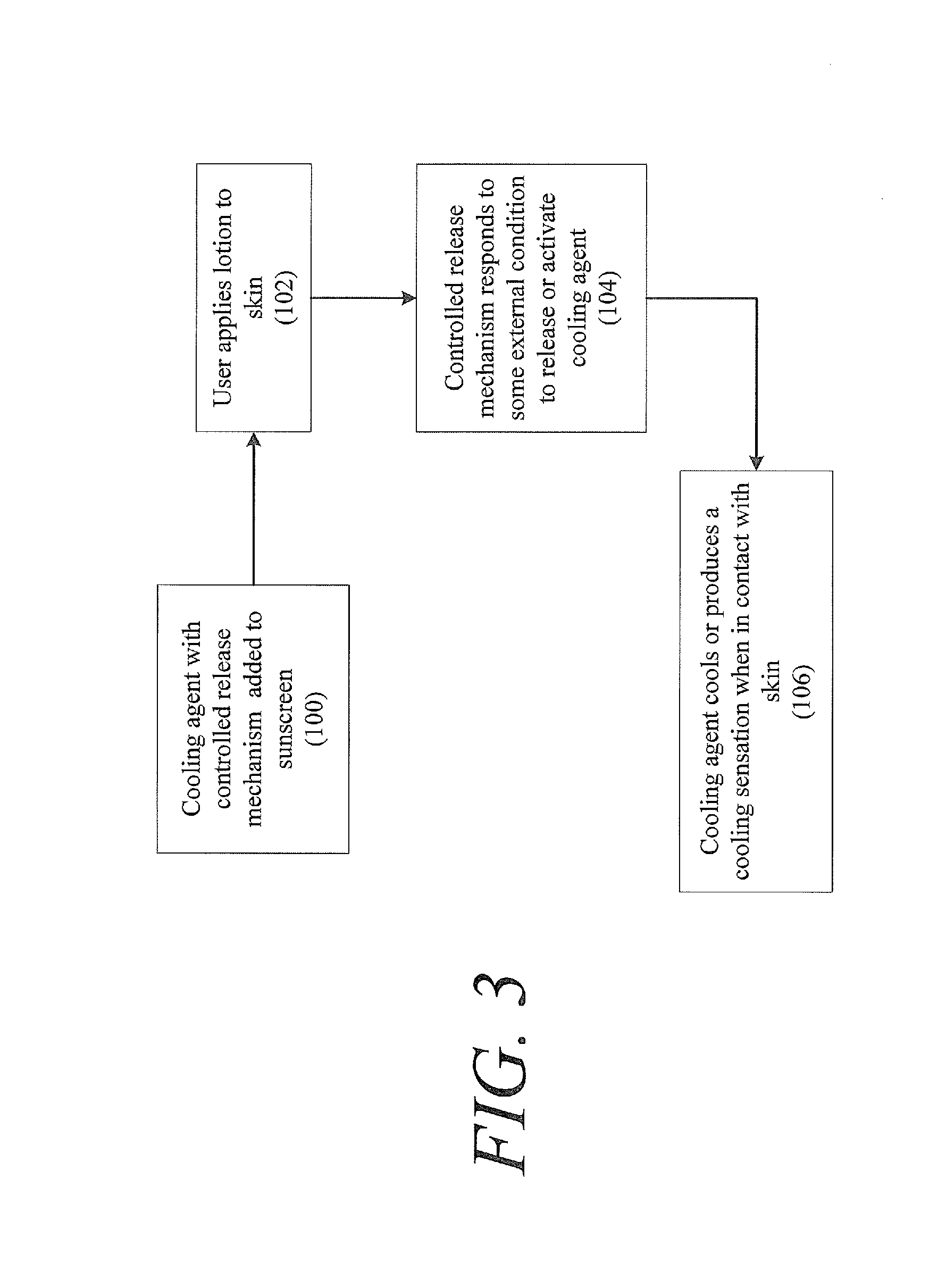Sunscreen with cooling agent
a technology of sun protection lotion and cooling agent, which is applied in the direction of pharmaceutical active ingredients, medical preparations, toilet preparations, etc., can solve the problems of skin feeling warm or even hot, heat may become uncomfortable on the skin, and absorb potentially harmful radiation to different degrees
- Summary
- Abstract
- Description
- Claims
- Application Information
AI Technical Summary
Benefits of technology
Problems solved by technology
Method used
Image
Examples
example 1
[0034]In a first example, the cooling agent is incorporated in a carrier or encapsulated in an encapsulant that releases the cooling agent in the presence of moisture. Thus, perspiration, indicating that the user is feeling warm, or other moisture on the skin can release the cooling agent to produce the resulting cooling effect.
[0035]Within this first example, a specific formulation is shown in FIG. 4. As shown in FIG. 4, a cooling agent, for example, menthol or a menthol derivative, in liquid form, is absorbed into silica (110). The silica serves as a carrier and as a controlled release agent for the cooling agent over an extended time.
[0036]Additionally, a solubilizing agent, also in liquid form, is likewise absorbed into silica (112). Examples of solubilizing agents include, but are not limited to, polyglycol, polyethylene glycol, polypropylene glycol, or a mixture thereof. Other suitable solubilizers known to those skilled in the art may also be used. Again, the silica serves as...
example 2
[0042]In a second example, the cooling agent is incorporated in a carrier or encapsulated in an encapsulant that is degraded by exposure to ultra-violet radiation, which is present in sunlight. For example, the cooling agent may be encapsulated in weakened polymer (hybrid) shells. Polymers shells comprised of low-density polyethylene or aromatic rings readily degrade upon prolonged exposure to ultra-violet radiation.
[0043]In this example, as the user's skin is exposed to sunlight, the ultra-violet component of the solar radiation will gradually degrade the carrier or encapsulant of the cooling agent. As this degradation progresses, the encapsulant will eventually release the cooling agent in a time-controlled manner.
[0044]In this example, the cooling agent may be stored in varying quantities of a carrier or encapsulant. Consequently, some of the cooling agent stored in a relatively lower amount of carrier or encapsulant is released first. An additional quantity of the cooling agent ...
example 3
[0047]In another example, the cooling agent may be captured within oleosomes. This example will be illustrated with reference to FIG. 6.
[0048]Oleosomes are naturally-occurring microparticles (400) found within seeds, botanicals and nuts. These oleosomes consist of a core of vegetable oil and vitamin E (401) that is surrounded by a phospholipid membrane and protein coat (402). In contact with skin, the oleosome (400) breaks down and releases its contents. Where this content is the natural oil and vitamin E, the oleosome serves to deliver this as an emollient and emulsifier to the skin.
[0049]Additionally, oleosomes are capable of absorbing and delivering other substances, such as the cooling agent described herein. Simple mixing of oleosomes (400) with the desired cooling agent an result in the cooling agent (403) being loaded into and protected by the oleosome (400). The loaded olesomes (400) can then be added to a sunscreen.
[0050]When the oleosomes (400) come into contact with skin,...
PUM
| Property | Measurement | Unit |
|---|---|---|
| solubilizing | aaaaa | aaaaa |
| thickness | aaaaa | aaaaa |
| (UV) wavelengths | aaaaa | aaaaa |
Abstract
Description
Claims
Application Information
 Login to View More
Login to View More - R&D
- Intellectual Property
- Life Sciences
- Materials
- Tech Scout
- Unparalleled Data Quality
- Higher Quality Content
- 60% Fewer Hallucinations
Browse by: Latest US Patents, China's latest patents, Technical Efficacy Thesaurus, Application Domain, Technology Topic, Popular Technical Reports.
© 2025 PatSnap. All rights reserved.Legal|Privacy policy|Modern Slavery Act Transparency Statement|Sitemap|About US| Contact US: help@patsnap.com



